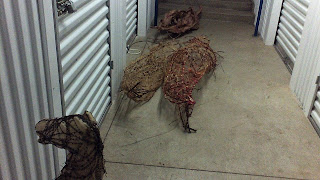 |
| I am NOT going to watch this! |
 |
| Artwork in the Storage Facility hallway. |
. . . .but of course it meant we had to go and GET the stuff.
Now here's the deal about downsizing onto a boat: One of the most common comments we got when planning our move aboard went something like "I could never do that, where would we put all our things?!" It is those "things" that are the problem. We are, to a very great extent, owned by our possessions. We spend a lot of time and money not only on our stuff, but on places in which to safeguard and maintain that stuff, even if we never even look at it.
Going into this, we read a number of downsizing accounts from livaboards and from those in the tiny house movement. The advice we took from that goes rather like this:
a) If you haven't touched, looked at, used, thought about, or tripped over something over the last two years, you don't need it and won't miss it.
b) Get a storage locker for everything else. Gradually pull out the things you find you can't live without and figure out some way to keep them with you. Whatever's left at the end of that time, you don't need.
It's proven pretty true for us as well. The things in our storage fell into four rough categories:
1) Family Memorabilia. What the hell do I do with this stuff, some of it from the 1830's? I feel like I'm the custodian for it in some way, but who gets it after me? This is always a problem. The stuff just lurks there in bins and boxes, defying you to dispose of it improperly.
2) Tools, kitchen stuff, and assorted devices that we know we'll need eventually(or wished devoutly we had brought with us), but have no real room for on the boat. Eventually, some of this finds its way back aboard. The rest can go away.
3) In our case, artwork and supplies (Morgainne is a visual artist) and manuscripts and costuming (I'm a writer and theatre geek). This stuff has value, and represents either works available for sale or works in progress. Much of it is problematic for a boat due to size or fragility. I suppose this category might, for most folks, also include things like important papers like titles, tax forms, etc., and collectables that might have resale value.
4) This Box (as in: "What the hell is in this box!?"). Stuff that got slammed into boxes, bins, crates, and bags at the last desperate minutes when we were doing our final move out. Moving storage spaces gave us the opportunity to revisit some of this stuff and a bit of it went straight into the dumpster.
 |
| Carefully layering framed artwork. We broke a few anyway. |
First, if you don't know your final destination, don't guess. Opt for a storage facility near your point of departure, which will at least minimize the effort expended on THAT part of your downsize. Otherwise, you risk putting your stuff someplace you wind up not being.
Second, plan on a serious revisit of your storage at about two years after your downsize to see just how much, if any, of that &%&$ you really need to be paying to store.
Whatever you do, know that the downsize is not only possible, it makes for a cleaner, far less stressful life. Once it's done, it's done, and you no longer have to go about dragging all that stuff like a snail dragging its shell. Enough Said.
More later
M
Hey new stuff over at life Art Water.
No comments:
Post a Comment